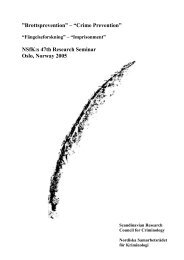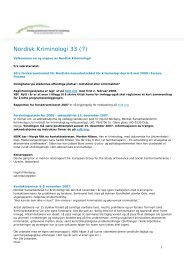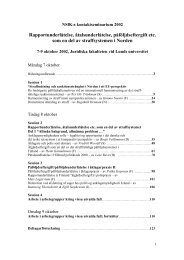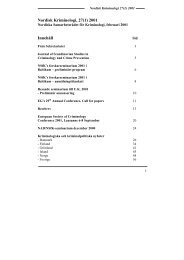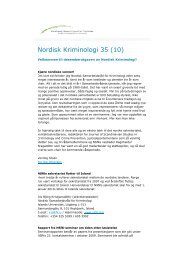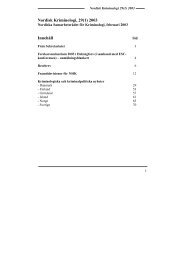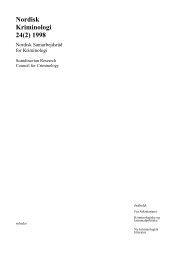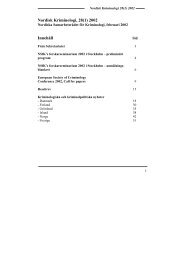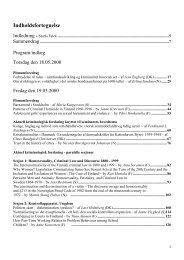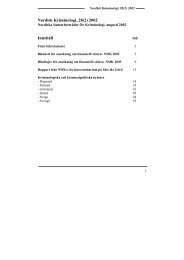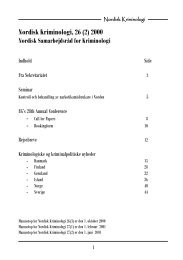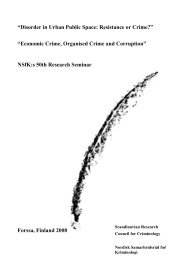Organised Crime & Crime Prevention - what works? - Scandinavian ...
Organised Crime & Crime Prevention - what works? - Scandinavian ...
Organised Crime & Crime Prevention - what works? - Scandinavian ...
Create successful ePaper yourself
Turn your PDF publications into a flip-book with our unique Google optimized e-Paper software.
NSfK’s 40. forskerseminar, Espoo, Finland 1998<br />
difference found as regards the time elapsed from participation in a treatment programme to<br />
commencement of the next prison term, between those who completed the programme and<br />
those who did not. Nevertheless, the prisoners completing the programme returned later to<br />
prison than the others. The former returned to prison in 19.5 months on the average, while the<br />
latter returned after a period averaging 14 months. Eleven of the returning prisoners were<br />
granted a second opportunity to complete their sentences by a treatment programme, and one<br />
prisoner was granted a third opportunity in the period coming under the study.<br />
Discussion<br />
Since 1990, a total of 120 prisoners have been afforded the opportunity of completing their<br />
prison sentences by participation in an alcohol and drug abuse treatment programme offered<br />
by SAA. In order to make it possible to discern any differences in the return rates to prison of<br />
those who completed the entire six week programme and those who failed to do so, the<br />
decision was taken to extend the study to at least four years from the termination of<br />
participation, in order to obtain a realistic picture of the return rates. In 1990-1993, forty-eight<br />
prisoners were afforded this option. Of these, slightly less than three fourths completed the<br />
treatment programme, but slightly more than one fourth terminated their participation at their<br />
own request or as a result of various disciplinary offences in the course of the programme. No<br />
statistically significant difference was found between the two groups, in spite of a<br />
considerable proportional difference. This may be due to the small number of individuals<br />
providing the sample. Further research is needed, and returns to prison of offenders who<br />
undergo a treatment programme while serving a sentence will continue to be monitored.<br />
It is however noteworthy that the return rate of both groups (63%) was rather high, and<br />
considerably higher than the return rate of the prisoners studied by Sigurdsson and<br />
Gudjonsson (1997), which showed that four out of every ten individuals admitted to Icelandic<br />
prisons for serving a sentence over a period of four years had served a prison term earlier. A<br />
recent study of Norwegian offenders who completed their prison sentences by an alcohol or<br />
drug abuse treatment programme, conducted by Ødegård and Amundsen (1998), revealed a<br />
higher rate of recidivism (90%) than that of those who did not participate in a programme of<br />
this kind (81%). One explanation for the high recidivism rate of the Icelandic prisoners<br />
undergoing such a programme is without doubt linked to their criminal records, as their<br />
records were both longer and graver than those of the prisoners studied by Sigurdsson and<br />
Gudjonsson. The prisoners in the present study were, on the average, approximately four<br />
years younger than the prisoners they studied, who averaged 27 years (SD=8.7) when they<br />
served their first prison sentence. The members of the present study sample had also served<br />
more terms in prison and had received more unconditional sentences than the members of<br />
their sample, who had previously been sentenced by an average of 5.1 (SD=5.2)<br />
unconditional sentences and had served an average of 2.8 (SD=2.9) prison terms.<br />
Another explanation of this high return rate can undoubtedly be traced to the alcohol and drug<br />
problems of the sample members, as this was the reason why they applied for a completion of<br />
their sentences by drug abuse treatment in the first place. It may be assumed that their drug<br />
abuse problems are proportionally greater than those of other prisoners, who did not lodge<br />
such applications. One deficiency of this study is the fact that no information was available on<br />
the prisoners’ use or consumption of alcohol or illicit drugs, nor the nature of their problems,<br />
at the time they applied for participation in the treatment programme. The only dependable<br />
information on alcohol and drug use by Icelandic prisoners is to be found in the studies of<br />
Sigurdsson and Gudjonsson (1994, 1995 and 1996). Their study (1995) of 340 Icelandic<br />
prisoners concluded that 13% were regarded as seriously dependent on the abuse of drugs,<br />
136



